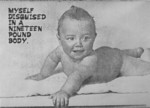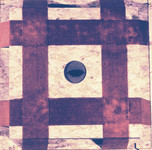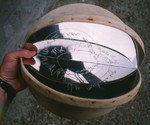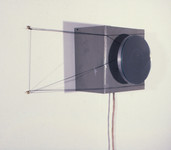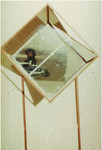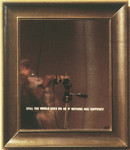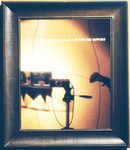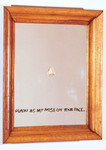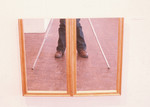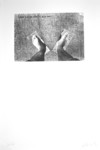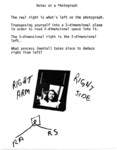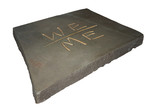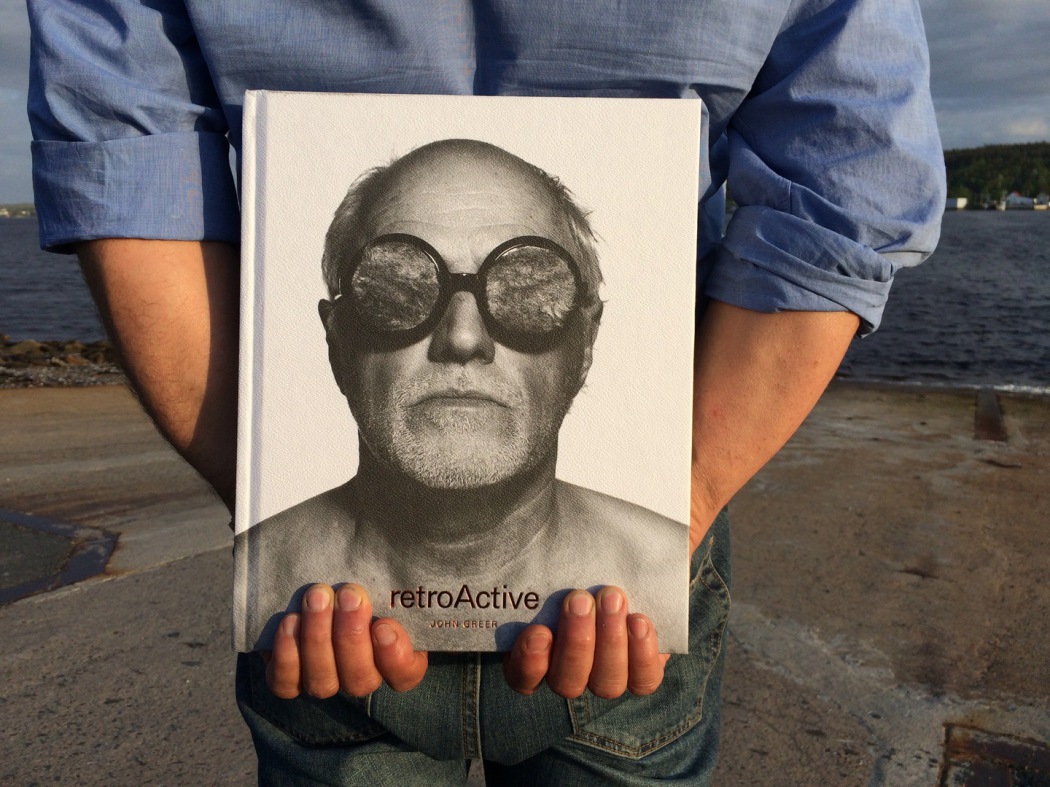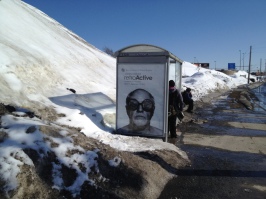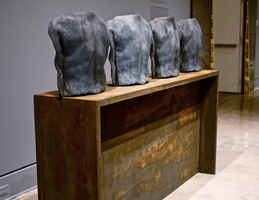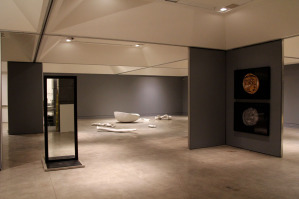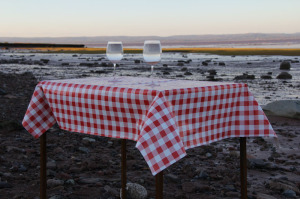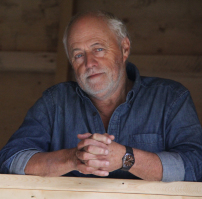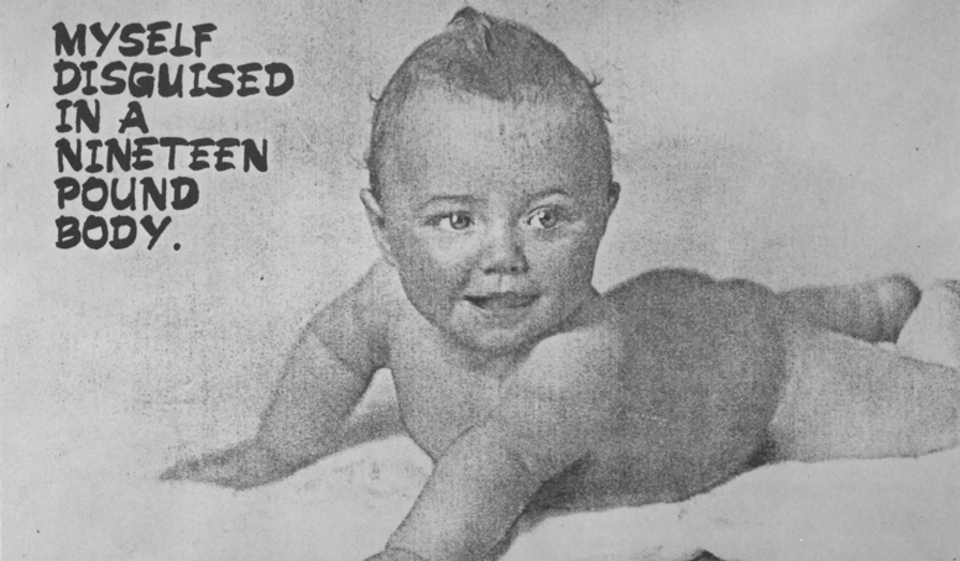
WHO AM I IF THAT IS ME?
"The recognition of the own image in stagnant water and in the mirror
is probably one of the first hallucinations that man ever had."
Michelangelo Pistoletto
"The trouble with mirrors is,
they do not reflect, they throw back an image." Jean Cocteau
"Myself disguised in a nineteen pound body", 1974 (photo). For Greer the "I" is undergoing a transformation through many forms. So the appearance is just a temporary thing, the soul is taking on costumes, is appearing in disguise.
As a baby you are one with the universe, so full and rich, that there is no room for the knowledge of any directed articulation. By learning how to deal with the surrounding - how to function, you have to give up this one-ness, this being one with the world. (Greer compares that to feeling home, lost in a snowstorm. The moment when a snowstorm makes you the center of the universe, being in there, all alone, surrounded by whiteness. This phenomenon can also be experienced by swimming under water.) Ideally, at the end of a life, you return to this richness, you return to the silence of your own mind. Greer is doing art in order to make sense of his being and the world that is surrounding him. "Art is an impossible end in itself, but is a direction of total awareness in merging with the universe.” (John Greer)
At the age of fourteen, he had a moment of epiphany when looking at himself in the mirror, one of these profound encounters that occurred once in a while in his life and usually made him change direction. He saw his face in the mirror - which became an almost traumatic experience as he realized a dislocation, a double vision by "being" and "being projected, being an idea" - now, which one was the real? Greer took both and called them "me" and "I". "When you look at your image in the mirror, your consciousness is not there. You see yourself as some kind of a zombie. You dislocate your consciousness.” (John Greer)25
Nevertheless, the direct visual perception of our self is not possible - we can only look at parts of us. The head, the neck, shoulders, our back are not visible to our own eyes. In order to know about our appearance, we have to rely on the reflection of a plain - on water, glass, metal or - the mirror!
Michelangelo Pistoletto, who's work is signified by the use of mirrors, says: "I think that the first intellectual experience of man was the recognition of his image in the mirror (water surface), but I do not think that this experience should be embodied by the myth of Narcis: I do not think that the beginning of history could be signified by an instinctive and irrational action of passion of man. This myth describes man as driven exclusively by his instincts. Instead, I think you should search for the beginning of history, going back to the times, when man recognized his own image in the mirror, an image that is separated from the self as double, as representation of the self, that is a symbol of his own personification. This is the point in time at which the phenomenon of rationality is revealed." (Michelangelo Pistoletto)26
Greer got this insight on the phenomenon of rationality at this specific day in his childhood. He developed a problematic research into the identity of the self and the dangerous belief in the illusionary reality that is built up in ones mind through the image of oneself in the mirror.
Always closer to the world of objects than to the construct of language or a signification through images, Greer starts to tempt the man-made constructs in his work through mirror-pieces that work on a very intimate level, tempt the viewer's perception at the moment of encounter. The mirror, being a reflection and a medium for speculation (spekulum = mirror) is used for a reflection - that is reflecting - on the reflection of the self. He uses it as a tool, not criticizing the fact of illusion, but sensitizing the viewer for it and provoking a questioning of its relative importance and right- or better wrongness.
Plato's mirror is the following: "...(it is blind) It does not look AT the idea, either, (a looking that is the case in mimesis), but provides images. The mirror does not look; apparitions appear in it, nothing more. The mirror is blind: he does not see what is. It seems to see: that is his highest appearance. Also, the looking into the mirror, through the mirror, is nothing but mere image. In reality, the mirror imagines what is NOT. For Plato it is, in opposition to the existing, a screen (and as such not traversable)." (Massimo Cacciari)27
If you accept the mirror as highest form of fiction and illusion, than you can operate with it as a useful tool. You have to know who you are, and where your mental construct, the rationality, is touching your being. If that border is defined, than your being is defined through your human capabilities, which is a state of awareness, of being one.
"Truthfully, you only see, if you look at the idea MERELY INTELLECTUALLy. That is the nature of those two mirrors from which we started. Essentially, the true mirror is the EYE: the mirror of the eye. Only in the mirror of the eye things do exist as they are, true to reality. All the others are deceiving mirrors, creators of imaginations. More radical: seeing is not really reflecting or speculating; seeing is INTUITIVE COMPREHENSION. Seeing does not have the quality of reflection." (Massimo Cacciari)28
Greer is trying to get us close to this kind of seeing, tries to open our eyes by confronting us with mirrors that try to fool us - mirrors that are a bit different from what we know - and from what we do not always remember.
"Neither here nor there" is the title of two different mirror works. The first was done in 1973. Here the mirror is a device for a revelation of personal placement. The piece consists of a small hand-mirror that is mounted to the wall at a slight angle in head-height. Expecting to see yourself on the surface of the object, you are surprised to be confronted with a blind surface, which is reminding you in writing that the deceptive image of your face is dislocating you anyway. In this case in a double sense, by questioning its absence.
Greer uses language in order to reduce the illusion of space "inside" of a mirror to its real two-dimensionality. This becomes even more obvious in a mirror from 1974 "In behind there over to the right a little". The same words are engraved in the surface of a blank mirror. It is a fictitious directive for how and where to find yourself in the illusion of the mirror-space. By focusing on the words, your image becomes blurry; you use the mirror surface (writing) as the tool when starting the search for your image. In the depth of illusion, the letters become blurred; you are dislocating your self from reality through your mental capability.
So, in fact, Greer’s works are like exercises into the world of illusion: Ten times in a row, twice a week, and you should be mentally fit!
The second version of "Neither here nor there" 1979/1990 works also through the combination of language with a mirror construction. Here the dislocation of yourself is visualized by the reflection of your image beside yourself, instead of right in front of you. Greer's use of the mirror in the pieces that have words applied on the surface can be seen in succession of examples from antiquity, where images of social encounter were engraved on the polished surface of a mirror made from metal. Besides the reflection of oneself, one was always aware of the reflection as a mental construct and in the social act, as reflection on reality.
Greer relates the definition of the "I" to our organs of visual perception and of personal identification, the eyes. For him this implies a problematic in our perception, which he likes to express through the comparison with language: "We have two "eyes", but we have the single "I" in the language in the first person. You are two "I"s as a concept, (with two "eyes" as a fact, the author), and I think, what makes you beside yourself is the dislocated consciousness - because you can not think from that space." (John Greer)29
"In the first person" 1976 deals with that problematic. Two small mirrors, mounted in head-height to the wall are facing each other with a short distance in between. On the backside of the one that is turned against the wall, the reflecting surface is scratched off in the shape of a human eye. Peeping through that hole, you see your single eye reflecting into infinity. "More than meets the eye" 1976,1984,1990 is working differently, by taking control over both of your eyes in your mirror vision. The dislocation of perception is somehow really taking place. It questions the true forces that control a person's vision and view. "This "I" introduced the concept of duality, i.e. an image which can be irresponsible as compared with the universal centre of events. Within this mirror your image is reduced to near reality. (John Greer)30 In fact, you really never see eye to eye with yourself, you always think from the inside of your own individuality - which becomes a different type of mirror for Greer: "Never seen Eye to Eye with myself" 1975. It consists of two bronze casts of the eye area (closed eyes) of a human face, mounted on glass. It is a cast image which makes it possible to have a person's eyes facing each other - really not - since they are closed and, well, made out of bronze. Here he shows the paradoxical contradiction of "seeing" ourselves.
The problem of the image was taken up through mirrors in various forms. Greer wanted to find out what the "me" was in the part of the reflection. "Just a little closer still" 1976 is showing a paradox confusion of a very ordinary encounter. The mirror facing the viewer is starting to rotate by turning the switch - our image, naturally, is resting stable. This work is tempting the intuition versus the intellect, since there is always this first moment of engagement, which makes you wonder why your image does - not - turn. This mirror is questioning our stability of perception and makes us loose faith in mirrors. Another example of training the viewers perception is "Over and Out" 1979. Philip Hicks wrote in a humorous and engaged critic about this work: "Just inside the door is a mirror - a revolving type - but with a difference. Normally, when you stand in front of a reflecting surface, no matter what you do with it, whether you turn it around, set it askew, or upside down, you, the standing-in-front, you stay put; you remain upright. Not so with Greer's Over and Out. Rotate the mirror a quarter of a circle - only - and you are upside down; make it 180 degrees, and you are the right way up again. Ugh? Ughgu! That is not the end of it by any means. Have you ever tried to read a letter or a book held in front of a mirror? Normally the words run back to front; in Greer's special mirror, they are the right way round and read easily. This exhibit - you are encouraged to play with it, as with all the others - encapsulates the whole show in that it raises the question of what is reality." (Phillip Hicks)31. This work is almost more tempting our intellect than our perception, since it is playing with our expectations of what a mirror and an image does, which we - so the artist - should better not forget: you are looking at an illusion and not at yourself.
So these insights in the double meaning of the human mirror reflect in turn on themselves, being reflections of us as a person that is an individual in the world. A mirror is always about vanity, about making an image of oneself, of how we want to be seen by others. But: "Long before a mirror is about vanity, it is about objectifying oneself, seemingly seeing yourself in the world, and in a way outside of yourself. I say seemingly seeing, because it is always an illusion, a very powerful illusion. The fact remains, each consciousness is a center of consciousness, and the image in the mirror is not what you are or where you are, even if the image is no longer backwards." (John Greer)32
"Still the world goes on" (Reflections beyond the mirror) 1979,1990 talks about the importance of the individual. Language is used in order to build up the threshold between us and the mirror, which opens up into what is behind us, into the world surrounding us. The importance is directed towards our subjectivity - which in turn is asking for self-authority.
Self-authority and responsibility for oneself in response to others are subjectified in works like: "Plain as my nose on your face" 1973, "I look like a little dog" 1971, "End of a full length image" 1974, or photo works like "Standing on my own before the age of 30" 1972, or "notes on a photograph" 1970.
These works have in common that they all look trivial and ordinary. Greer hopes that their levity in tone works as threshold to help viewers into art, and what he connects with it, into a relevant thinking about the sense of being.
Through his research into the mirror image, the problematic took on a double meaning for Greer, which made him think about different types of mirrors. One of them is the "WE/ME Stone" from 1983. It is reflecting the individual on the community. "The "WE/ME Stone" is also a type of mirror, a device for self-reflection. It is based on the threshold word "WELCOME" - the threshold where the individual meets the world. The WE and the ME are reflections of each other - more of an integration and less of a separation - where you see yourself in others and not like the mirror image where you see yourself as another." (John Greer)33 The act of reflection becomes a device in the artist's object installations that is included in the act of encounter. His mirrors become more about the revelation of human mental construct as part of what we call reality. "Humble Endings - Sayonara" 1978,1990 is another step in that direction. It becomes a mirror that is inside of a person. So this piece is not really humiliating the viewer, but is opening him up for an experience of self-reflection.
Greer objectifies our sense of seeing in a way that relates to the understanding of Plato. Greer's investigations in his steps towards the current work are showing a similar concern as Plato's description of the limits by looking in a mirror and the act of "seeing" itself. The mirror is a device which reveals the connection of our mind with our body and therefore to the world. The image is useful as a tool that is revealing insight into the essence of being. This "essence" is what Greer applies with the term "center of consciousness". For him it is most important, that this centering is in a balance, which is only achieved by a conscious way of looking at images, especially images in the mirror. Reflections are part of our being - not any more and not any less. They are not "us" and they are not "without us".
"The image in the mirror reflects a centre of experience that is not separate as it appears in the mirror. If you recognize this image as yourself, there is a dislocation of the centre of consciousness. This powerful illusion causes powerful repercussions. It encourages a belief that things can stand alone, that closed systems are possible. It affects your ability to respond in the world, and when the potential for irresponsibility is increased, you may lose your personal authority and your humanity." (John Greer)34
With his mirrors, Greer developed a sensibility for the encounter of images, which he started to use as a tool for following works. For him, illusion matters in the true sense of the word. His exhibitions are a form of sharing his investigations and therefore they are educating the viewer. Prepared through early works like the described pieces, you have the necessary awareness in order to approach his following sculptural statements for a meaningful encounter.
25 John Greer in conversation with the author, Berlin, march 1997
26 Michelangelo Pistoletto, Spiegelbilder, Kunstverein Hannover, 1982 "Der Spiegel", p.158
27 Massimo Cacciari, "Der Spiegel Platons", Was heißt "Darstellen"?, Suhrkamp 1994, p.114
28 Massimo Cacciari, ibid. p.112
29 John Greer in an interview with the author, Berlin, march 1997
30 John Greer, Sculptural Objective, Art Gallery of Nova Scotia, 1981
31 Phillip Hicks
32 John Greer in a statement on the show "Never the same after words", 1990
33 John Greer in a statement on the work, 1983
34 John Greer in a statement from 1990
